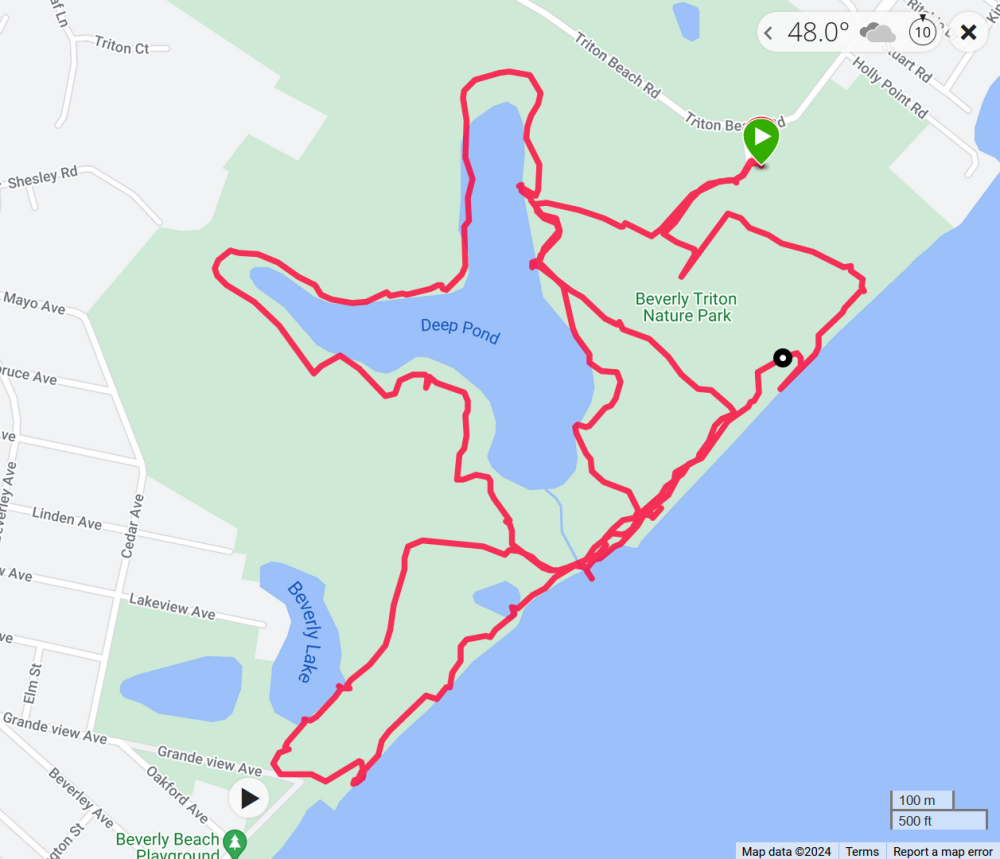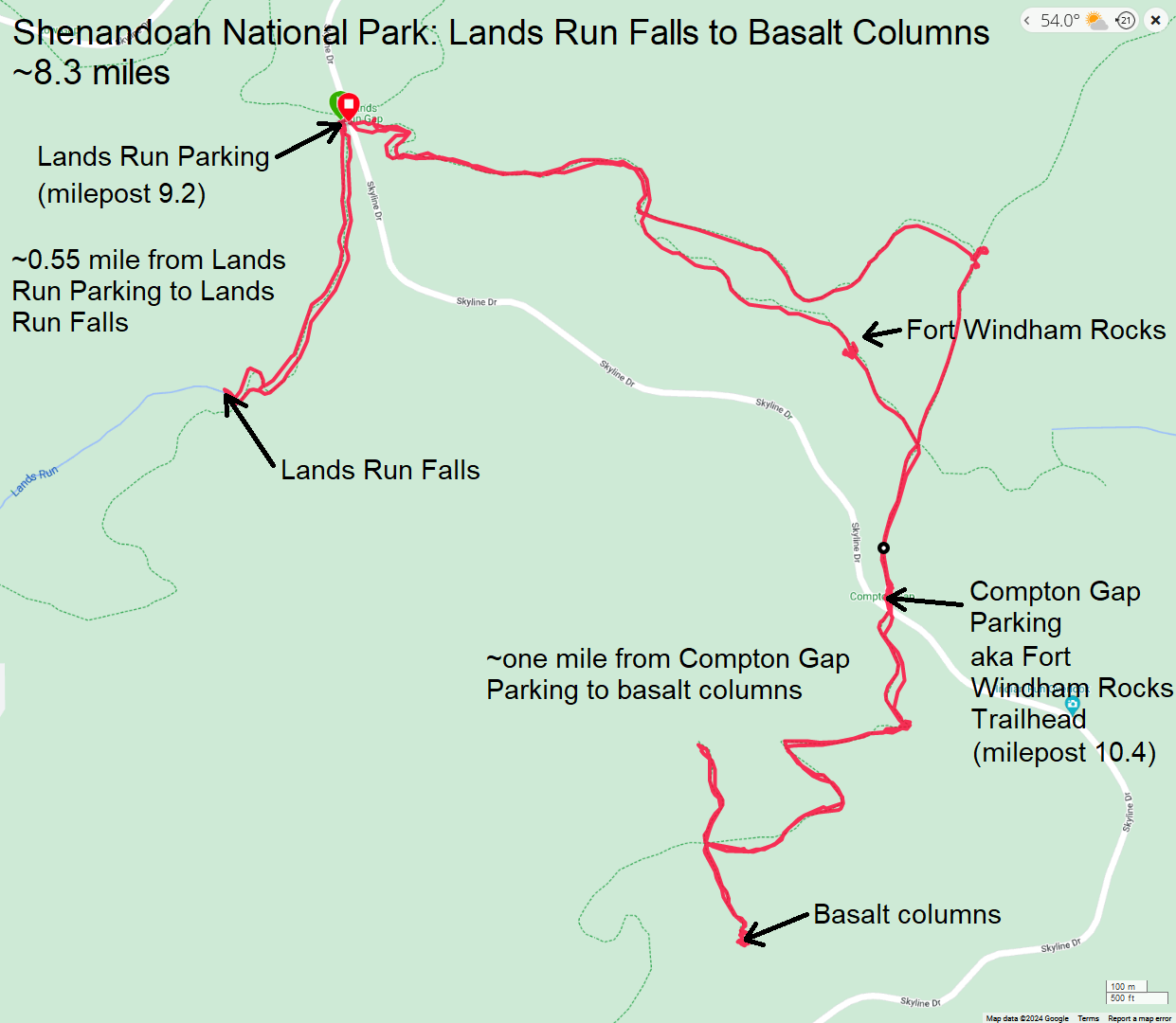|
This page describes my hiking adventures in 2024. |

|
This page describes my hiking adventures in 2024. |

|
Daphne and I have launched at Beverly Triton Nature Park but this is the first time we hiked it. I'd been waiting for a not-so-warm day because I suspected it might be buggy. It was cool and sunny.
Our first stop was the tot lot. Much of the park faces the Chesapeake Bay. Here's Daphne on one of the concrete and rock jetties. It was a little windy...hence the earflip. There were quite a few people out walking, along with several dogs. They mainly stayed along the Beach Trail. If those other dogs are anything like Daphne, they really enjoy the feeling of sand between their toes. Someone built a nice home for mason bees. I saw no residents. I passed a couple of people on bicycles. I found an eagle nest overlooking the southwest side of Deep Pond. I don't know what this is. Maybe it is a football blocking sled for Andrew the Giant. I saw a few deer. Daphne somehow missed them. Here's our route. We got in 4.8 miles. 
 |

|
Back on Christmas Day 2023, Daphne and I explored the trails at Greenbury Point. At the time, Norma was with her family so she could not join us. But I knew she would enjoy this hike so I vowed to return with her.
We parked at the Greenbury Point - Nature Center and then ventured south on the Bobwhite Trail, following the route at AllTrails - Greenbury Point Trail. We walked on the scenic Poet's Nature Trail which parallels Carr Creek. I missed this part on my previous visit. The trail was well-maintained, well drained, and wooded. Next, we walked on the peninsula where we had a nice view of the Severn River. I showed Norma the leftover foundations of previous radio towers and the three remaining ones. We saw an osprey with the Chesapeake Bay Bridge in the background. Earlier on our walk, we saw a pair of V-22 Ospreys in flight. We also spotted some bufflehead ducks. Quite a few people were out walking their dogs but not nearly as many as on Christmas morning. The three of us walked 3.4 miles.  |

|
After my morning paddleboarding trip with Daphne, I drove us on the Critical Area Driving Tour (CADT) to a small parking area just south of Mattaponi Creek at the edge of Merkle Natural Resources Management Area. From here, we walked across the wooden bridge over the creek where I saw an osprey on its nesting platform.
On the north side of Mattaponi, we commenced to explore the red trail in Patuxent River Park. It had been several years since I walked on this section. It was extremely scenic, especially the area along Old House Creek. Looking down on it, I saw a very impressive beaver dam. At various points on the trail, I saw signs of recent activity. We saw many of signs of spring and this made me happy. I only wish I had seen more wildlife...a snake would have been great! I found an old, abandoned small shack. I heard a couple barred owls. I spent quite a bit of time looking for them but never saw them. I knew I was quite close to one. Because I spent so much time looking, I don't think we really covered much distance, even though we were out for at least an hour. But that gave Daphne plenty of time to sniff...one of her favorite pastimes. Completing my drive of the CADT, I saw a turtle in the road. It wasn't going anywhere so I simply moved it to the side so it wouldn't get run over.  |

|
It is that time of the year when morel mushrooms are emerging so Norma insisted we go foraging. We grabbed Daphne and then headed out to the Hell House - Bonnie Branch Road.
On Bonnie Branch, I saw the Bonnie Branch stone dam, the place I refer to as my favorite man-made waterfall. Here are concrete remains of Bonnie Branch Mill just downstream of the dam. It was considered a merchant mill...whatever that means. I explored the ruins at the Hell House just briefly. I'm not sure what this brick structure was. Pretty much everything here was part of the ruins from Saint Mary's College, built in 1868. Here's looking down inside the brick structure. Unfortunately, we found no morels, even where we had spotted some previously.  |

|
After our brief foraging stop at the Hell House, Norma, Daphne, and I moved onto Patapsco Valley State Park - Woodstock to continue our search.
We commenced our hike on the Baltimore County side of the Patapsco River heading downstream. Just off the trail near a creek, Norma found two small morel mushrooms. Unfortunately, that is all we found for the day. We passed a very small and scenic waterfall. There was lots of muscovite lying around. Before humans learned to make glass from quartz, the finest window panes were formed from large sheets of muscovite. Although not perfectly transparent, these window panes were far superior to an uncovered opening or window coverings made from cloth and animal bladders. - from University of Minnesota - Muscovite We spent a lot of time looking for morels near the railroad bridge. The water was pretty high. Just across the river, I spotted a Pileated Woodpecker. It was also foraging. The three of us crossed the railroad bridge. I was concerned it would not be safe to do so if a train came by but there was a metal section off to the side that made crossing easy. We returned to our destination via the shortest route on the Howard County side of the park. It was a perfect day, in terms of weather. But in terms of foraging, it was mediocre at best.  |

|
Norma and I don't often get to see Carmen so we consider it a treat whenever she visits. I was hoping to take the two of them and Daphne out kayaking on the Susquehanna River to Indian Rock Island to see the cormorant and great blue heron rookeries but with 30+ mph wind gusts, such a trip was clearly unsafe. So instead, we drove out to Shenandoah National Park - Lands Run for a day of hiking.
We headed south on Lands Run Fire Road until we reached Lands Run Falls. After seeing the falls, we returned to where we started, crossed Skyline Drive, and then hiked east on Dickey Ridge Horse Trail and Springhouse Trail. Norma was looking for morel mushrooms. We found none. But we did see various flowers in bloom. We headed south on the Appalachian Trail until we came to the Compton Gap Parking Lot. This is where we wanted to start but by the time we arrived, it was full. I was looking for snakes and, like the morels, they were not out. But I did see other fauna or their remains. We crossed Skyline Drive again and continued south on the Appalachian Trail. Along the way, we encountered a taste of what was to come. It was a very special geologic formation known as basalt columnar jointing. Columnar jointing is a geological structure where sets of intersecting closely spaced fractures, referred to as joints, result in the formation of a regular array of polygonal prisms, or columns. - from Wikipedia - Columnar Jointing At the next trail intersection, we headed south to Compton Peak East. Even without many leaves on the trees, the view wasn't so great because of all the foliage. Here is a zoomed-in view between some branches looking southeast. Heading downhill and south from Compton Peak East, we came to our main destination. One thing I learned about photographing the basalt columnar jointing in the afternoon is that bright light produces harsh shadows. I think it is best to take pictures when there is cloud cover. There were some other visitors to these rocks but not many. This place is fairly unknown. That's part of what makes it so special. Hiking north, we crossed back over the Appalachian Trail and then continued to Compton Peak West. Here's a view looking northwest. At this location, we really caught the full force of the 30+ mph gusts. Back on the Appalachian Trail, we retraced our steps heading north. But instead of taking Springhouse Trail west, we walked on Dickey Ridge Trail heading west. After walking for a short distance, we encountered Fort Windham Rocks on the north side. These rocks rise as much as 50 feet above the ground. I don't know how this place got its name. Fort Windham Rocks and all the greenstone in this area are part of the Catoctin Formation, a series of related lava flows in Virginia, Maryland, and southern Pennsylvania. These rocks are being broken apart, little by little, by the power of ice and frost. Because the rocks at Fort Windham are covered with lichen and weathering rapidly, they feature some fascinating colors. - from Compton Gap Parking trailhead sign We hiked a total of 8.3 miles that day. I would say our elevation gain but I've grown to mistrust my Garmin when it comes to that information. 
Shortly after leaving the park, we stopped at the Apple House for dinner. The place reminded me a bit of the Cracker Barrel but with more of a Shenandoah feel. The food was very good and reasonably priced. It was a great day to get outside and I'm really happy Carmen could join us.  |

|
On April 19-20, 2024, Norma, Daphne and I did a couple of short hikes in the lower Delmarva area near Cape Charles, Virginia. These included the Brownsville Nature Conservancy and the Eastern Shore of Virginia National Wildlife Refuge.
|

|
From May 24 to June 3, my mom visited. I took her on several short, local walks in the area.
 |

|
After paddleboarding on the Patuxent River with Daphne, I stopped at the Saint Thomas Church Road trailhead in Patuxent River Park to take her for a short walk. Here, we were able to access the Red Trail.
There were some big, beautiful trees near the trailhead, such as this chestnut tree which glowed yellow with catkins. Soldier beetles flew and crawled all over the tree. Soldier beetles mainly feed on pollen and nectar. Because of their frequent contact with flowers, soldier beetles are important pollinators. They do not damage flowers or other plants and are harmless to people. - from University of Minnesota Extension - Soldier beetles The first part of the trail passed by a big, open farm field. Then we turned right into the woods and walked by a creek where we saw a frog. We also saw an American toad. I'm guessing we only walked about a mile. Daphne spent the last few hours standing on a SUP so I didn't want to wear her out...just give her a little exercise and the opportunity to sniff everything she wanted.  |

|
Several years ago, I did a "splash hike" with the Howard County Sierra Club. This is a great way to get outside and enjoy at really hot day. Walking through the water helps you stay cool and even if you don't get wet, the air along a creek is almost always cooler than the air further away from the creek in the summer.
Fellow kayaker Marla A. led a fossil hunt for the Natural History Society of Maryland Fossil Club. I recently joined so I could attend this event. It wasn't advertised as a splash hike but that's kinda what it was. We weren't confined to one location, looking for prehistoric finds...we were wading though a stream that flows into Henson Creek. Marla did a lot to prepare for this trip. She led us through a place I did not know existed to find the fossil remains of an animal I also did not know existed, the Cucullaea Gigantea. The Cucullaea Gigantea is an extinct species of false ark shell found in the Aquia Formation in Maryland, Virginia, and Alabama. They flourished in marine environments during the Paleocene ranging from 58.7-55.8 million years ago. According to Got the Time - Cucullaea Gigantea, this shell is a now extinct bivalve from the Paleocene. These guys were infaunal suspension feeders, meaning they burrowed into the seafloor and strained their food from the water. By now the shell had completely eroded away, but what was left is a perfect mold of the interior composed of the greenstone. When this creature died, a small opening was left so that sediments could fill in and later harden into rock. As time passed, the more easily weatherable shell went away and all that remained was the more durable greenstone. C. Gigantea is about twice the size of its relatives such as Cucullaea recendens averaging about 8 - 14 cm in length, while C. Recendens averages 5 - 8 cm. Finding marine fossils in a Maryland creek bed also shows that it was once a marine environment. Cucullaea Gigantea is hard for me to remember and pronounce so I'll use their nickname, "turtle head," though I think "Sleestak head" would be more appropriate. How are these fossils formed? They are actually what's called an "internal mold" of a type of clam from the Cretaceous period named Cucullaea gigantea - the genus is still around today, called the 'false ark clams'. How do these form? - from Facebook - Mace Brown Museum of Natural History at the College of Charleston Most of the turtle heads had the color of stone in the area. But a few still had some of their original chalky exterior. On some of the more detailed turtle heads, you could see crimps around the edge. This made them look like empanadas. The creek was a nice place to explore. Despite having some recent rain, the section we walked was usually no deeper than my rain boots are tall. There were some big tree downfalls but nothing we couldn't get past easily. Here's Doris looking for prehistoric remains. Turtle heads weren't the only fossils we found. Someone recognized Skolithos Linearis. So what are these strange "straw like" lines in the stone? We aren't sure exactly what life form made them, because any trace of them disappeared long ago, but it was more than likely a "worm like" creature. What we do know is that they made these tubes or burrows when the sediment was still soft. These tubes have been given a specific name called "Skolithos Linearis." - from Virginia Department of Conservation and Recreation - More than Meets the Eye I recognized a Turritella, something Marla had not seen in this area. These are any of several species of gastropods (snails) abundantly represented in fossil and living form from the Cretaceous Period, which began about 144 million years ago, up to the present. - from Britannica - Turritellid There were numerous shell impression fossils. Impression fossils are a type of trace fossil. Impression fossils form when a leaf, shell, skin, or foot leaves an imprint in soft earth. When the imprint hardens, it forms a fossil in the shape of the original object. - from Activity: Make an Impression Fossil I found a few Ostrea (oyster) fossils. These may not look all that old but it has been a really long time since this creek was able to support such life. Near where we turned around, one side of the creek had a lot of embedded shells. While these embedded shells looked rather random, a few formed a clearly recognizable pattern. Below, you can see the heart-shaped corgi butt-side of a turtle head with a turtle head fossil placed above for comparison. I uncovered one fossil which we were not able to identify. I posted it on a fossil social media post and someone thinks it is a bivalve of the genus Pinna. Others agree. Another person thought it was horn coral but I don't think that is correct. I think it resembles a sea walnut. I was also hoping to find snakes and arrowheads but did not. I did find wineberries and wood ear fungi. This was a great trip and I have Marla to thank. I am greatly looking forward to participating in other Natural History Society of Maryland Fossil Club activities.  |

|
During August 31 to September 13, 2024, I did lots of short hikes on the San Juan Islands and Olympic National Park.
 |

|
Norma, Daphne and I stopped in at the Greenbelt Farmers Market to pick up lunch and then walked the Watkins Park Loop at Watkins Regional Park.
Over the previous days, Hurricane Helene hit further south and brought plenty of rain to Maryland. That created a perfect environment for mushrooms to grow. We saw quite a few, only some of which I could identify. Perhaps the most unusual mushrooms we saw were stinkhorns growing out of a break in the asphalt. These visually-shocking fungi get their common name from their characteristic, unpleasant odor. Because stinkhorns can grow on dead organic material, they actually are beneficial in that they contribute to the recycling of plant debris into nutrients that improve soil fertility and can be used by garden plants. - from Wisconsin Horticulture - Stinkhorns The three of us walked through a farm area complete with animals. We also saw a historic carousel. There was no shortage of interesting things to see. Here's Norma and Daphne at a wooden snake sculpture. We walked about 1.8 miles.  |